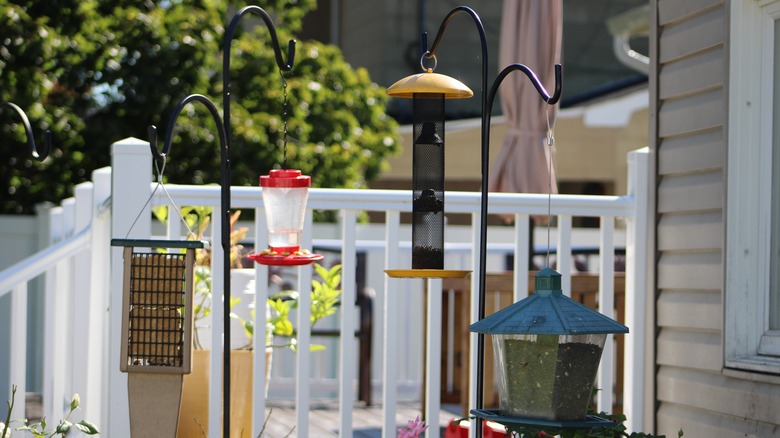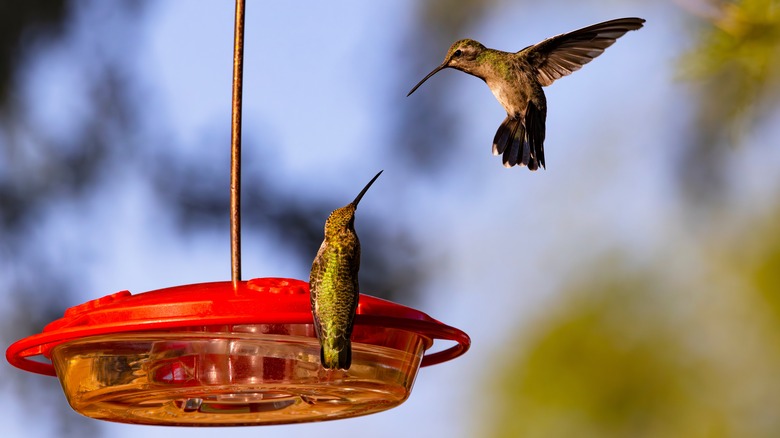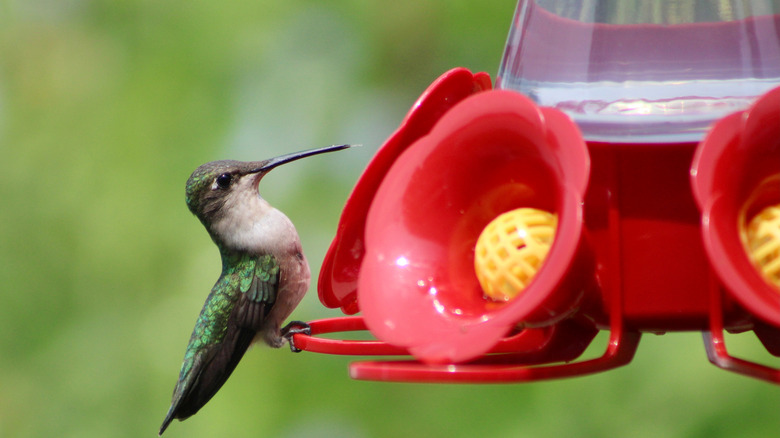Why You Might See Fewer Hummingbirds In Your Yard After Switching Out Your Feeder
If you enjoy birdwatching and look forward to hummingbirds visiting your yard, having them suddenly disappear can be heartbreaking. The good news is that if you've recently switched your feeder, you probably already know the culprit — and it can be easily remedied.
Hummingbirds like their routines, and if they spot a new feeder, they can take up to two weeks to start using it. Everything from the way they have to land on the feeder to how they drink from it may be different than what they're accustomed to, and they'll need time to figure it out. All you have to do is be patient while also ensuring you've placed the feeder outside early enough.
While the West Coast and the South in the United States enjoy these birds year-round, the East Coast and Midwest typically see them arrive between March and May. You'll need to hang your feeders before that so they don't get used to visiting others in the area instead. However, if more than two weeks have passed and the hummingbirds still haven't started using the new feeder, there are a few proactive actions you can take, from swapping its location to sweetening your sugar water.
How to entice hummingbirds to try a new feeder
If hummingbirds are continuously ignoring your new feeder, there are a number of tricks you can try. First, move the feeder closer to flowers or plants in your yard while removing all other existing feeders. For example, lupines are hummingbird magnets, and these birds can't get enough of beardtongues, so if you have either growing in your garden, move the feeder closer to them. This should encourage the hummingbirds to try the new, unfamiliar nectar dispenser. You can also try sweetening the deal. The homemade nectar they love traditionally consists of a four-to-one ratio of boiling water and white sugar, respectively, but you can temporarily increase the sweetness to offer the birds an incentive to try the new feeder.
What's more, you can make the feeder itself more enchanting. Hummingbirds respond positively to bright colors, particularly red. While you never want to use artificial dyes in your sugar water, you can cover the outside of your dispenser with decorations, such as a red ribbon, to make it more attractive. Also, note that if your new feeder is made of metal (rather than plastic or glass), it may become too hot or cold for the hummingbirds to use safely depending on the season, leading them to ignore it altogether. Finally, don't skimp on weekly cleanings. Whether human or hummingbird, no one wants to eat or drink from a dirty vessel.
How to properly clean your feeder so it's attractive to hummingbirds
There are a number of errors you don't want to make with your feeder, and one of the biggest is forgetting to clean it. If you're hoping hummingbirds will be attracted to your feeder and use it regularly, you'll need to change its nectar twice a week (or more often if you notice it's become murky). At the same time you swap the sugar water, take your feeder apart and flush it with warm water to rid it of impurities. The British Columbia Society for the Prevention of Cruelty to Animals (BC SPCA) also recommends disinfecting the feeder with a mixture of vinegar and water — a one-to-four ratio is best — every week to stop fungus and bacteria growth.
Because of the nectar's high sugar content, your feeder will be particularly susceptible to mold. If you notice even the smallest amount, take it apart immediately and wash it thoroughly in a gallon of water mixed with ¼ cup of bleach. Similarly, ants are likely to be attracted to the sugary nectar, which will cause hummingbirds to avoid it. To quickly and cheaply remedy this, consider purchasing an ant moat for your feeder if it doesn't already have one. Then, with all of these preventions and solutions on hand, your feeder should be good to go for as long as your hummingbird season lasts.


